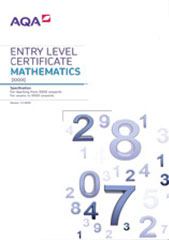3.2 Component 2: the four operations (calculator not allowed)
This content aims to develop the student’s understanding and use of the four operations.
Students will undertake calculations using mental arithmetic involving addition, subtraction, multiplication and division.
Procedures for making and recording assessments
Class work assessed by the teacher in response to the outcomes set out below, or assessed by an externally-set assignment.
Outcomes to be accredited
In successfully completing this component, students will have demonstrated the ability to:
Entry 1
|
Outcomes |
Notes/examples |
GCSE reference |
|---|---|---|
|
1.1 Add two whole numbers with a total up to 20 |
Zero can be one of the numbers Key words are add, sum, total, altogether Use the = sign to represent equality |
N2 |
|
1.2 Subtract one number up to 20 from another |
Zero can be the number subtracted Key words are take, take away, subtract, difference, how much more, how much less |
N2 |
|
1.3 Understand and use the + and – signs to solve simple number problems |
Work out 5 + 11 6 = 10 - ? Understand that subtraction is the inverse of addition |
N2, N3 |
Entry 2
|
Outcomes |
Notes/examples |
GCSE reference |
|---|---|---|
|
2.1 Add whole numbers with a total up to 100 |
N2 |
|
|
2.2 Subtract one number up to 100 from another |
N2 |
|
|
2.3 Multiply using single digit whole numbers |
Key words are multiply, multiplication, times … lots of Understand that multiplication is the same as repeated addition |
N2 |
|
2.4 Use and interpret +, -, × and = in real-life situations for solving problems |
Dan had some sweets. He ate 13 and had 8 left. How many sweets did he start with? |
N2 |
|
2.5 Recall and use multiplication facts for the 2, 5 and 10 multiplication tables |
Entry 3
|
Outcomes |
Notes/examples |
GCSE reference |
|---|---|---|
|
3.1 Add and subtract using three digit numbers |
N2 |
|
|
3.2 Multiply a two digit whole number by a single digit whole number |
N2 |
|
|
3.3 Divide a two digit whole number by a single digit whole number |
Key words are divide, division, divided by, share equally, equal groups of’ Understand that division is the same as repeated subtraction Understand that division is the inverse of multiplication Interpret the remainder in a practical situation |
N2,N3 |
|
3.4 Use and interpret +, –, x ,÷ and = in real-life situations for solving problems |
Could be multi-step Kim bought three packs of 12 eggs. She used 4 eggs on Monday and 5 eggs on Tuesday. How many eggs did she have left? |
N2 |
|
3.5 Use inverse operations to find missing numbers |
Work out the missing number 35 + ? = 124 |
|
|
3.6 Estimate the answer to a calculation |
||
|
3.7 Recall and use multiplication facts for the 3, 4 and 8 multiplication tables |
